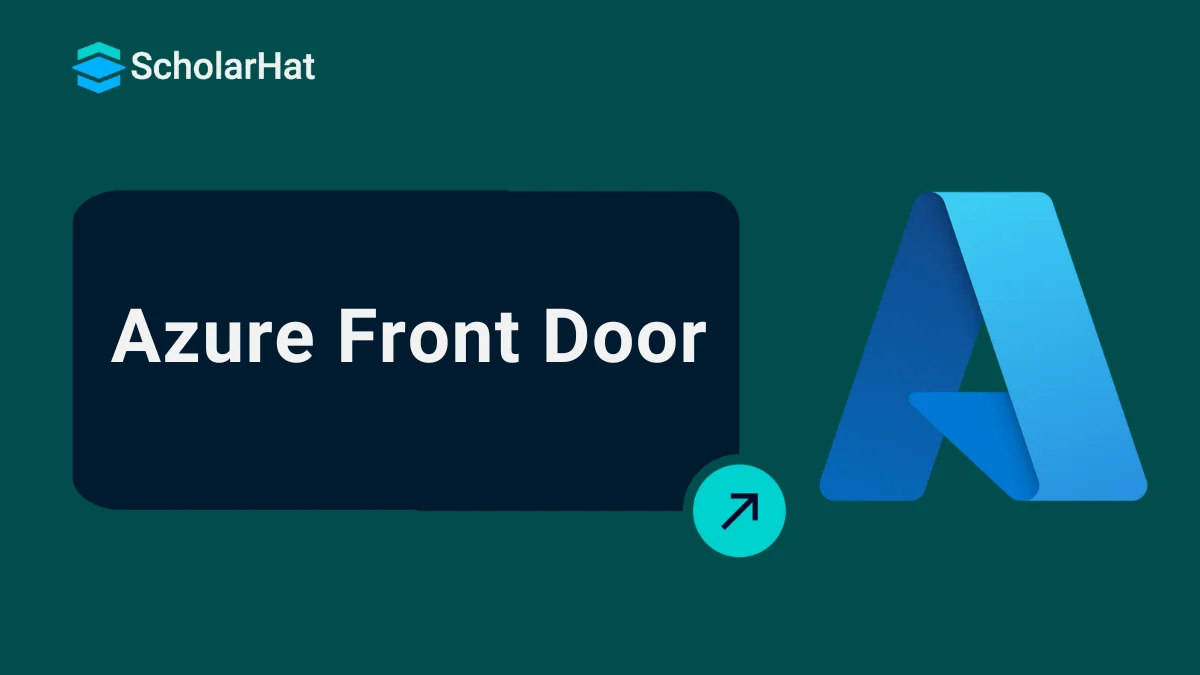26
DecUnderstanding Azure Front Door (Features, Architecture and Uses)
Azure Front Door
Azure Front Door is a globally distributed, secure entry point for delivering high-performance web applications. It combines a Content Delivery Network (CDN), global load balancing, and Web Application Firewall (WAF) to optimize content delivery, ensure high availability, and protect against threats. By intelligently routing traffic to the nearest and healthiest backend, it enhances speed, scalability, and security for users worldwide.
When you create a web application with Azure, don't you also want it to be fast and secure? Of course, everybody wants everything should run efficiently while data remains secure. This is possible with Azure Front Door.
This Azure Tutorial will take you into the details of Azure Front Door in detail, its Features and Benefits, Azure Front Door vs CDN, etc. 65% of cloud-related jobs will require Azure Fundamentals knowledge. Start your journey with our Free Azure Fundamentals Course today!
| Read More: Top 50 Azure Interview Questions and Answers |
What is Azure Front Door?
Azure Front Door is a globally distributed application delivery network offered by Microsoft Azure. It acts as a secure and scalable entry point for fast and reliable delivery of your web applications. By combining the features of a Content Delivery Network (CDN), global load balancer, and Web Application Firewall (WAF), Azure Front Door helps improve application performance, global scalability, and threat protection.
Azure Front Door intelligently routes user traffic to the nearest and most responsive backend, using various routing methods like latency-based routing, session affinity, and URL path-based routing. This ensures high availability, low latency, and enhanced user experience for modern web applications.
4 Core Capabilities of Azure Front Door
Azure Front Door is packed with powerful features that improve the performance, security, and availability of web applications. Below are four key capabilities that make it a preferred choice for modern, scalable applications:
1. Dynamic Site Acceleration (DSA)
Dynamic Site Acceleration (DSA) in Azure Front Door speeds up the delivery of both static and dynamic web content. It reduces latency by routing requests through Microsoft’s global edge network, ensuring faster load times, reduced round-trip times, and a better user experience, especially for globally distributed users.
2. Web Application Firewall (WAF) Integration
Azure Front Door seamlessly integrates with Web Application Firewall (WAF) to provide advanced application-layer protection. The WAF safeguards web apps from common threats like SQL injection, cross-site scripting (XSS), and bot attacks. It monitors and filters HTTP traffic, ensuring robust security without compromising performance.
3. Built-in DDoS Protection
Azure Front Door includes built-in Distributed Denial of Service (DDoS) protection, helping defend your web applications from large-scale attacks. It automatically detects and mitigates volumetric traffic spikes, keeping your app available, responsive, and resilient during malicious traffic surges.
4. Private Link Integration
Private Link integration enables secure, private access to your backend services by routing traffic over the Microsoft backbone network instead of the public internet. This improves data confidentiality, reduces exposure, and strengthens your network security posture, especially in compliance-sensitive environments.
Features Supported by Azure Front Door
Azure Front Door offers a comprehensive set of features designed to enhance the performance, reliability, and security of web applications. Below are some of the most powerful and widely used capabilities:
1. Health Monitoring and Automatic Failover
Azure Front Door performs continuous health checks on your backend services. If a service becomes unhealthy or unresponsive, traffic is automatically redirected to the nearest healthy instance, ensuring high availability and uninterrupted user access.
2. SSL/TLS Termination and Certificate Management
It simplifies SSL/TLS certificate management, securing data in transit between users and your web application. Azure Front Door handles encryption and decryption at the edge, enabling fast and secure HTTPS connections without burdening backend servers.
3. Intelligent Caching Strategies
With built-in caching support, Azure Front Door stores static content at edge locations, reducing latency and improving page load times. This boosts performance and enhances the overall user experience, especially for content-heavy websites and applications.
4. Advanced Bot Protection
Azure Front Door includes bot management features to detect and mitigate malicious bots. It intelligently distinguishes between legitimate traffic and automated threats, helping protect your application from scraping, credential stuffing, and DDoS attacks.
| Read More: Azure Roadmap to Become Azure Developer |
Azure Front Door Architecture
To bring your content nearer to users, Azure Front Door employs the global edge locations network of Microsoft. Routing rules, backend pools, health probes, and security policies are some of its components, which work in unison for quick and safe access to your applications.
How Does Azure Front Door Work?
Once your application is requested by a user, Azure Front Door processes and directs the user to the backend service closest and fastest. This results in faster and more reliable operation of your application while still reducing latency Security features like WAF and DDoS protection keep your application safe.
Why Azure Front Door Is Important in Modern Cloud Architecture?
- Deliver content at low latency
- Balance traffic across regions intelligently
- Secure applications against evolving cyber threats
- Ensure high availability even during failures
Benefits of Using Azure Front Door
Azure Front Door is a powerful, cloud-native application delivery service that offers a broad range of benefits to optimize performance, enhance security, and ensure global scalability. Here are the top advantages of using Azure Front Door:
1. Improved Performance- Azure Front Door routes traffic through Microsoft’s high-performance global edge network, delivering content closer to end users. Features like Dynamic Site Acceleration (DSA) and intelligent traffic routing minimize latency and boost application speed.
2. Enhanced Security- With integrated Web Application Firewall (WAF), DDoS protection, and SSL/TLS encryption, Azure Front Door helps protect your application from threats like SQL injection, XSS, bot attacks, and network-level intrusions.
3. Seamless Scalability- Designed for high-traffic, enterprise-grade applications, Azure Front Door automatically scales to handle millions of concurrent requests. It ensures consistent performance even during peak usage or global traffic surges.
4. High Availability and Resilience- Azure Front Door continuously performs backend health monitoring and supports automatic failover, routing traffic to the nearest healthy instance. This guarantees 99.99% uptime and reduces downtime during regional failures or outages.
5. Global Load Balancing- It offers smart load balancing across global regions using routing methods like latency-based routing, geo-filtering, and URL path-based routing, ensuring users are connected to the most responsive backend.
6. Simplified SSL/TLS Management- Azure Front Door handles SSL/TLS termination and certificate management at the edge, providing secure HTTPS connections without burdening your origin servers.
7. Intelligent Caching- Its built-in caching capabilities reduce backend load and speed up static content delivery. This significantly improves user experience, especially for media-heavy or eCommerce websites.
8. Bot Protection and Traffic Filtering- Advanced bot management features help detect and mitigate malicious automated traffic, protecting your applications from credential stuffing, web scraping, and other automated attacks.
9. Secure Access with Private Link- With Azure Private Link integration, you can securely access backend services over the Microsoft backbone network, avoiding exposure to the public internet and improving data confidentiality.
10. Developer-Friendly Configuration- Azure Front Door supports custom routing rules, redirects, and rewrite policies, offering flexibility for developers to tailor traffic management according to their application's needs.
When Is Azure Front Door Used?
Azure Front Door is an ideal solution for organizations looking to deliver high-performance, globally available, and secure web applications. Here are common use cases where Azure Front Door proves highly beneficial:
- Global Web Applications- For applications serving users across multiple geographies, Azure Front Door ensures a fast, reliable, and consistent user experience by routing requests through its worldwide edge network and performing latency-based traffic distribution.
- E-commerce Websites- E-commerce platforms demand speed, security, and reliability. Azure Front Door supports secure transactions, SSL offloading, WAF protection, and global caching, reducing checkout delays and protecting sensitive customer data.
- API Acceleration and Protection- For public-facing or internal APIs, Azure Front Door provides low-latency access, intelligent routing, and DDoS protection, making it ideal for modern, API-driven applications where performance and security are critical.
- Multi-region and Multi-cloud Deployments- In multi-region setups, Azure Front Door helps ensure high availability and disaster recovery by automatically routing traffic to the healthiest backend. It also integrates well in hybrid and multi-cloud environments, enhancing cross-region resilience.
- Mobile and SaaS Applications- Mobile apps and SaaS platforms benefit from Azure Front Door’s global load balancing, edge-based acceleration, and bot protection, ensuring responsive and secure user experiences from any location.
Azure Front Door Vs Azure CDN
| Azure Front Door | Azure CDN |
| Azure Front Door offers more advanced features like dynamic site acceleration, load balancing, and security. | Azure CDN focuses on delivering static content like images and videos. |
| It is more secure with Web Application Firewall, built-in features, SSL, etc. | It has only basic security features like DDoS and SSL. |
| It is suitable for applications needing advanced capabilities. | It is suitable for delivering large amounts of static content efficiently. |
| It can be a bit complex as compared to Azure CDN. | It is more simple. |
Azure Front Door WAF (Web Application Firewall)
- SQL Injection
- Cross-Site Scripting (XSS)
- Remote File Inclusion
- Command Injection
- HTTP protocol anomalies
Why Use Azure Front Door WAF?
- Provides centralized protection for globally distributed applications.
- Scales automatically to protect against large-scale attacks.
- Ensures compliance and regulatory readiness by protecting sensitive data.
- Integrates seamlessly with other Azure services like Azure Policy, Application Gateway, and Azure Sentinel.
We have discovered in this article the importance of understanding Azure front door, a robust service for secure and fast delivery of web applications.
Microsoft Azure Developer Certification holders earn up to ₹12 LPA. Secure your future with our Microsoft Azure Developer Certification Course now.
FAQs
Take our Azure skill challenge to evaluate yourself!

In less than 5 minutes, with our skill challenge, you can identify your knowledge gaps and strengths in a given skill.









